Brazilianite is a rare and highly valued gemstone named after its country of origin, Brazil. It is a phosphate mineral that belongs to the apatite group. Brazilianite is known for its vibrant green to yellowish-green color and its exceptional clarity. It is a popular choice among collectors and gem enthusiasts due to its rarity and unique beauty.
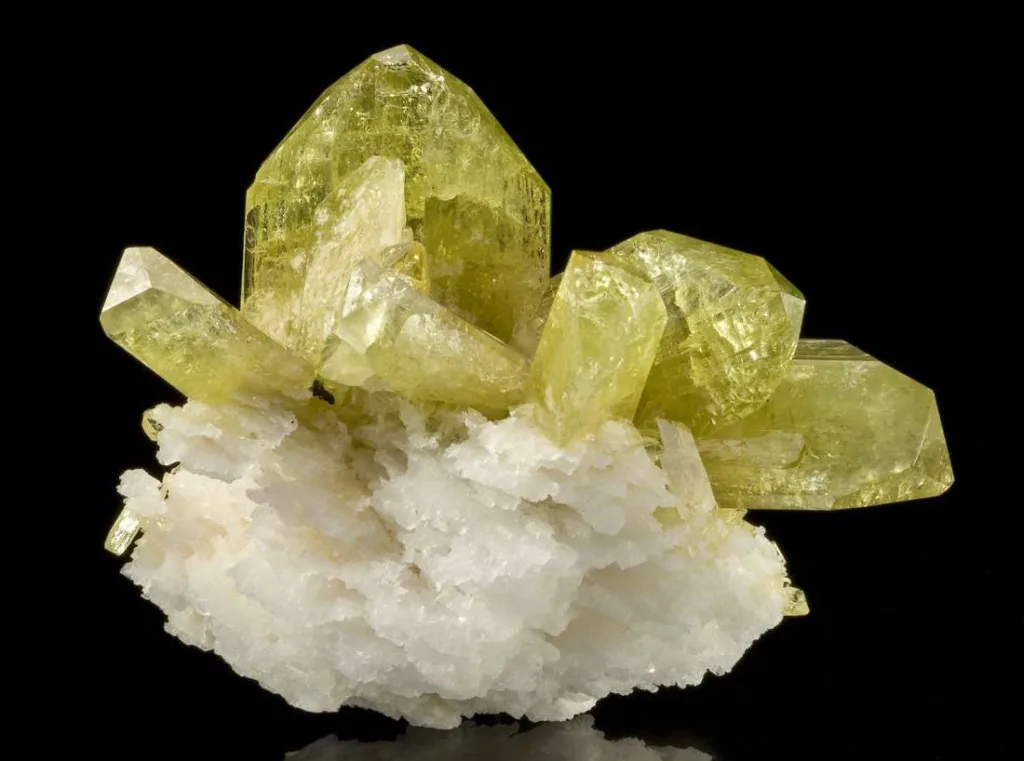
The mineral was first discovered in the state of Minas Gerais, Brazil, in the late 19th century. It occurs in pegmatite veins, which are coarse-grained igneous rocks known for producing a variety of gemstones. Brazilianite is typically found alongside other minerals such as albite, muscovite, and quartz.
One of the distinguishing characteristics of Brazilianite is its strong pleochroism, meaning it can exhibit different colors when viewed from different angles. Under natural light, it usually appears as a rich green color, but it may display yellow or yellowish-green hues in incandescent or artificial light.
Brazilianite has a relatively high hardness of 5.5 to 6 on the Mohs scale, making it suitable for use in jewelry. However, its perfect cleavage can make it vulnerable to damage if not handled carefully. It is often cut into faceted gemstones to enhance its brilliance and showcase its attractive color.
Due to its scarcity, Brazilianite is considered a collector’s gemstone, and fine-quality specimens can command high prices in the market. Its rarity and unique color make it an attractive addition to any gem collection or jewelry piece. However, it is important to note that Brazilianite should be handled with care and protected from heat and harsh chemicals to preserve its beauty.
Discovery and occurrence
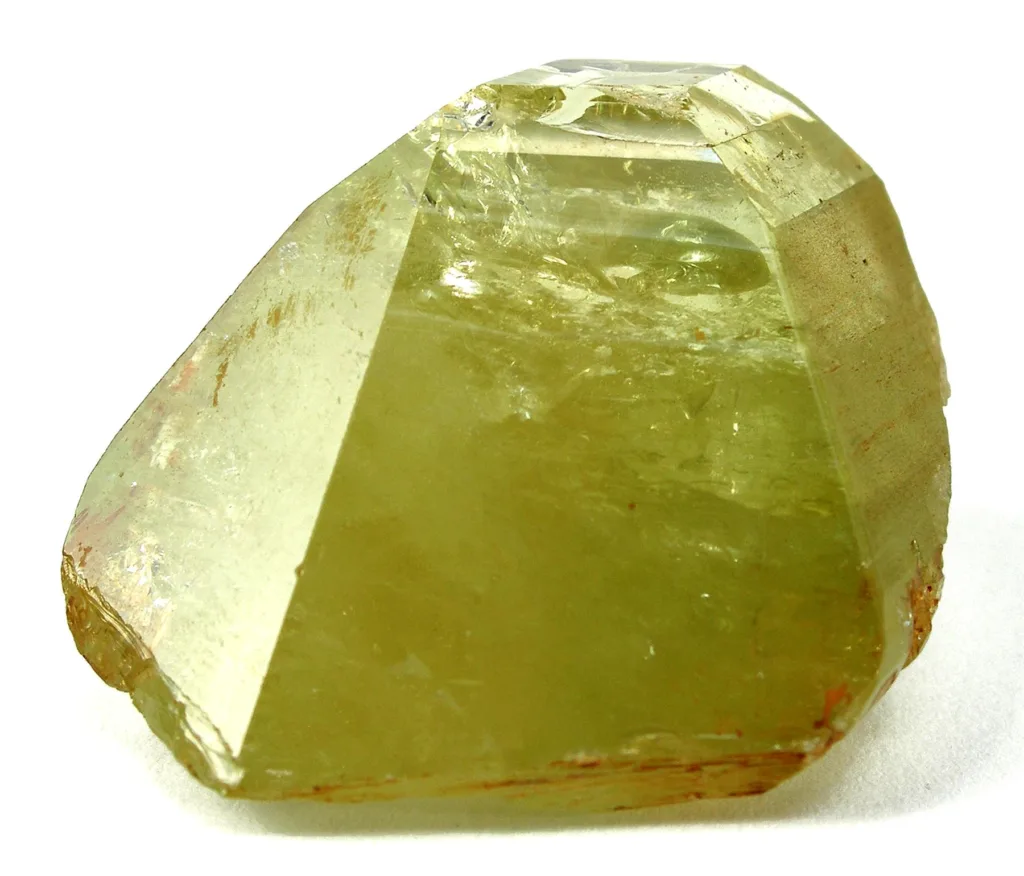
Brazilianite was first discovered in 1944 by the Brazilian geologist Djalma Guimarães in the state of Minas Gerais, Brazil. Guimarães named the mineral “Brazilianite” to honor its country of origin. The original discovery was made in the Conselheiro Pena pegmatite district, specifically in the Linópolis region.
Since then, Brazilianite has been found in several other locations around the world, although the Brazilian deposits remain the most significant and renowned. Additional occurrences of Brazilianite include the United States (New Hampshire, Maine, and California), Russia, Namibia, Afghanistan, and Portugal. However, the Brazilian specimens are generally considered to be the finest in terms of color, clarity, and overall quality.
Brazilianite is primarily found in granite pegmatites, which are coarse-grained igneous rocks enriched with minerals. These pegmatites often occur in association with other minerals such as albite, muscovite, tourmaline, and quartz. Brazilianite itself typically forms in small crystals or aggregates within the pegmatite veins.
The mineral owes its formation to hydrothermal processes, where hot fluids rich in phosphorus and other elements interact with the surrounding rocks over long periods. The specific conditions required for the formation of Brazilianite, including the right temperature, pressure, and chemical composition, contribute to its rarity and limited occurrence.
Although Brazilianite is not a widely available gemstone, it has gained popularity among collectors and gem enthusiasts due to its striking color and scarcity. Its vibrant green to yellowish-green hues, combined with its unique crystal structure, make it a sought-after mineral for both display specimens and faceted gemstones.
Chemical composition
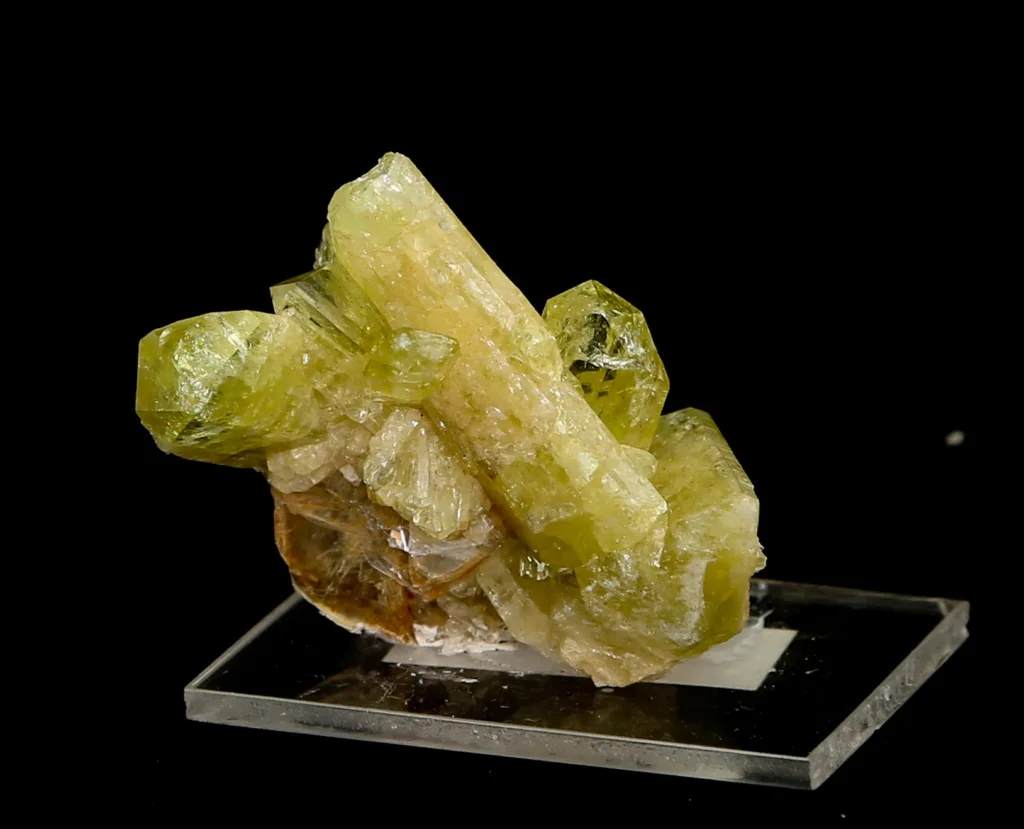
The chemical composition of Brazilianite is represented by the formula NaAl_3(PO_4)_2(OH)_4. It is a phosphate mineral that belongs to the apatite group. Let’s break down the formula to understand its composition:
- Na represents sodium, which is an alkali metal.
- Al_3 represents aluminum, a common metal element.
- PO_4 represents phosphate, which is a group of compounds containing phosphorus and oxygen.
- OH represents the hydroxyl group, consisting of one oxygen atom bonded to one hydrogen atom.
In Brazilianite, three aluminum atoms combine with two phosphate groups, forming the core structure. Sodium and hydroxyl ions occupy the spaces between the phosphate groups and aluminum atoms, providing charge balance and stability to the mineral.
The combination of aluminum, phosphate, sodium, and hydroxyl gives Brazilianite its unique properties, including its color, crystal structure, and physical characteristics. The presence of phosphorus also contributes to the mineral’s fluorescence under certain lighting conditions.
Crystal structure

The crystal structure of Brazilianite belongs to the monoclinic system. It is a member of the apatite group, which is characterized by a hexagonal crystal structure. However, Brazilianite itself is an exception within this group, as it exhibits a monoclinic crystal system.
In its crystal structure, Brazilianite forms elongated prismatic or tabular crystals with a flattened and wedge-shaped appearance. The crystals are often striated parallel to their length. The crystal habit of Brazilianite can vary, ranging from long slender crystals to more stubby and blocky forms.
The unit cell of Brazilianite contains layers of phosphate tetrahedra (PO4) and aluminum octahedra (Al(OH)4) that are connected together by sharing oxygen atoms. These layers are bonded together by sodium (Na) cations and hydroxyl (OH) anions, which occupy the interlayer spaces.
The arrangement of atoms within the crystal lattice gives Brazilianite its unique physical properties, such as its hardness, cleavage, and optical characteristics. The crystal structure contributes to the mineral’s ability to exhibit pleochroism, where it can display different colors when viewed from different angles.
Overall, the crystal structure of Brazilianite contributes to its distinctiveness and makes it a sought-after mineral among collectors and gem enthusiasts.
Physical properties
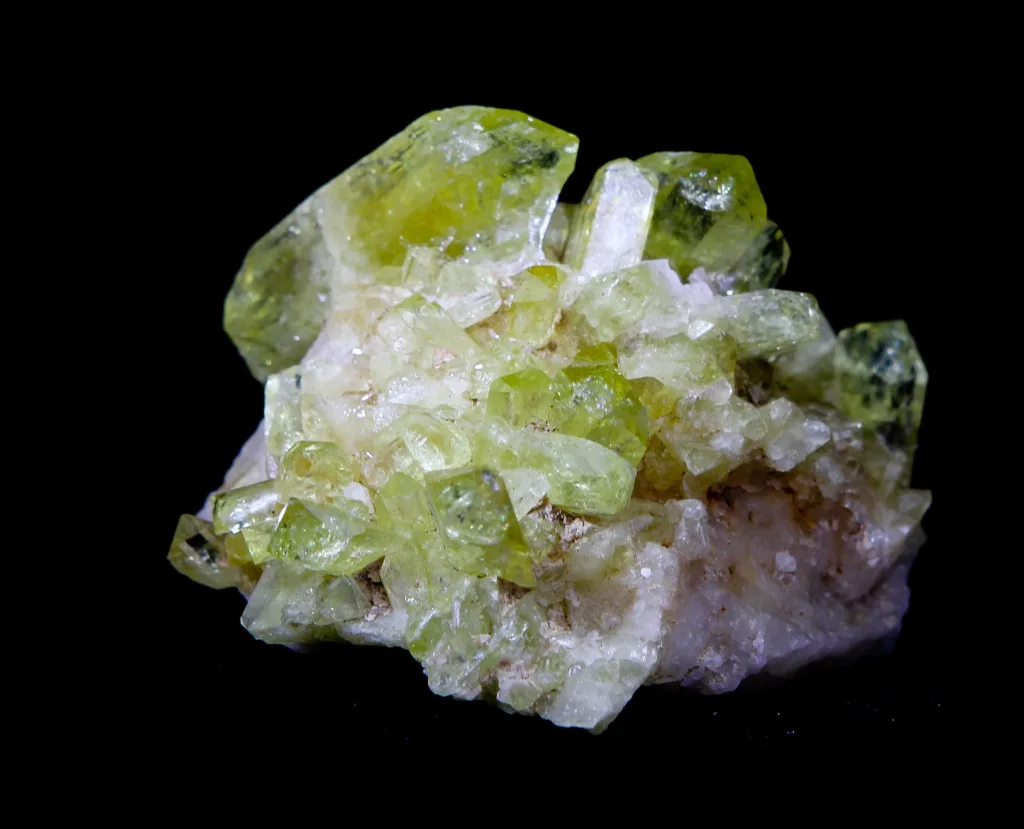
Brazilianite possesses several notable physical properties, which contribute to its identification and desirability as a gemstone. Here are some key physical properties of Brazilianite:
- Color: Brazilianite is most commonly recognized for its vibrant green to yellowish-green color. The intensity and shade of green can vary, ranging from pale and light hues to deep and intense greens. It may also exhibit yellow or yellowish-green colors in certain lighting conditions.
- Transparency: Brazilianite is typically transparent to translucent, allowing light to pass through its crystal structure. The transparency of Brazilianite allows for the display of its attractive color and internal clarity.
- Lustre: The lustre of Brazilianite is vitreous, which means it has a glassy and reflective appearance when polished.
- Crystal System: Brazilianite crystallizes in the monoclinic crystal system. Its crystals are elongated prismatic or tabular in shape, often with striations parallel to the length of the crystal.
- Hardness: On the Mohs scale of mineral hardness, Brazilianite has a hardness rating of 5.5 to 6. This places it within the range of materials that are moderately hard and can withstand normal wear and tear. However, Brazilianite’s perfect cleavage makes it susceptible to damage if not handled carefully.
- Cleavage: Brazilianite exhibits perfect cleavage along its crystal planes. This means that it can easily split or break along specific directions, requiring cautious handling to avoid fractures.
- Specific Gravity: The specific gravity of Brazilianite ranges from approximately 3.0 to 3.1. This value indicates that it is slightly denser than an average mineral.
- Pleochroism: Brazilianite displays strong pleochroism, meaning it can exhibit different colors when viewed from different angles. Under natural light, it typically appears green, while in incandescent or artificial light, it may appear yellow or yellowish-green.
These physical properties collectively contribute to the unique appearance and appeal of Brazilianite as a gemstone. Its vibrant color, transparency, and crystal structure make it a coveted addition to gem collections and jewelry designs.
Optical properties
Brazilianite exhibits several optical properties that contribute to its visual appeal. Here are the key optical properties of Brazilianite:
- Color: Brazilianite is renowned for its vibrant green to yellowish-green color. The exact color can vary, ranging from pale to intense shades. The presence of iron impurities in the crystal structure can influence the coloration, with higher iron content leading to a more intense green color.
- Transparency: Brazilianite is typically transparent to translucent, allowing light to pass through its crystal structure. This property enables the gemstone to showcase its color and internal clarity when cut and polished.
- Refractive Index: The refractive index is a measure of how light bends as it enters and exits a gemstone. Brazilianite has a refractive index ranging from approximately 1.599 to 1.630. This value indicates that Brazilianite has a moderate to relatively high refractive index, contributing to its brilliance and sparkle when properly cut and faceted.
- Birefringence: Brazilianite displays birefringence, which is the difference in refractive index between two crystallographic axes. The birefringence of Brazilianite is typically small, ranging from approximately 0.020 to 0.023. This property can give the gemstone a slightly blurry or fuzzy appearance when viewed through a gemological microscope.
- Pleochroism: Pleochroism is the property of exhibiting different colors when viewed from different angles. Brazilianite demonstrates strong pleochroism, displaying different shades of green, yellow, and yellowish-green depending on the orientation of the crystal. This property adds to the visual interest and allure of Brazilianite gemstones.
- Dispersion: Dispersion refers to the ability of a gemstone to separate white light into its spectral colors. While Brazilianite does not exhibit as pronounced dispersion as some other gemstones, it can still display a moderate amount of fire or color play when properly cut and faceted.
These optical properties contribute to the visual beauty and allure of Brazilianite gemstones. The combination of vibrant color, transparency, pleochroism, and moderate refractive index makes Brazilianite a captivating gemstone choice for jewelry and collectors.
Geographical Distribution
Brazilianite is primarily associated with its namesake country, Brazil, where it was first discovered. It occurs in several locations within Brazil, with the most notable being the Conselheiro Pena and Linópolis regions in the state of Minas Gerais. The Conselheiro Pena pegmatite district is particularly renowned for its Brazilianite deposits.
Apart from Brazil, Brazilianite has been found in other countries around the world, although its occurrences outside Brazil are relatively rare. Some notable international localities for Brazilianite include:
- United States: Brazilianite has been found in a few locations in the United States, including New Hampshire, Maine, and California. In New Hampshire, it is found in the Palermo Mine and the nearby Berry-Havey Quarry. In California, Brazilianite has been discovered in the San Diego County pegmatites.
- Russia: Brazilianite occurrences have been reported in the Murmansk region of Russia. It is found in association with other phosphate minerals in granite pegmatites.
- Namibia: Brazilianite has been found in the Erongo Mountains of Namibia, specifically in pegmatites within the region. Namibian Brazilianite specimens are known for their good transparency and rich green color.
- Afghanistan: Brazilianite has been discovered in the Kunar Province of Afghanistan. It occurs in pegmatite deposits within the region.
- Portugal: Brazilianite occurrences have been reported in the Barroca Grande pegmatite in Portugal. It is found alongside other phosphate minerals and gemstones in the area.
It’s important to note that while Brazilianite has been found in these international localities, the majority of high-quality and significant specimens still originate from Brazil. The Brazilian deposits remain the primary source of this rare and sought-after gemstone.
Formation and Geological Setting
Brazilianite typically forms in pegmatite veins, which are coarse-grained igneous rocks known for their mineral-rich composition. The formation of Brazilianite involves a combination of hydrothermal processes and the presence of specific geological conditions.
Pegmatites are formed through the slow cooling of magma, which allows for the growth of large crystals. They often occur in association with granitic rocks and are enriched in volatile elements and water. The presence of water and volatile elements is crucial for the formation of Brazilianite.
The formation process of Brazilianite begins with the intrusion of a granitic magma into the surrounding rocks. As the magma cools and crystallizes, the volatile-rich fluids and water present in the magma become concentrated in the remaining liquid phase. These fluids are highly enriched in phosphorus and other elements necessary for the formation of Brazilianite.
Under the influence of heat and pressure, the volatile-rich fluids migrate through fractures and fissures in the surrounding rocks. As they ascend, they encounter cooler conditions, leading to the precipitation of minerals such as Brazilianite.
The specific geological setting for Brazilianite formation involves the presence of phosphorus-rich minerals and a sufficient concentration of sodium and aluminum. The pegmatite veins act as conduits for the transportation of these elements and allow for the growth of Brazilianite crystals.
The primary occurrences of Brazilianite are associated with granitic pegmatites, often in regions with complex geological histories. These regions may have undergone multiple episodes of magmatic activity and tectonic events, leading to the formation of mineral-rich pegmatites.
Notably, the Conselheiro Pena pegmatite district in Minas Gerais, Brazil, is renowned for its exceptional Brazilianite specimens. The geological history and the mineral composition of this region have provided favorable conditions for the formation of Brazilianite crystals of exceptional quality.
Overall, the formation of Brazilianite is a result of the interplay between geological processes, hydrothermal fluids, and specific mineral compositions within pegmatite environments. This combination of factors contributes to the rarity and unique beauty of Brazilianite as a gemstone.
Uses and Applications
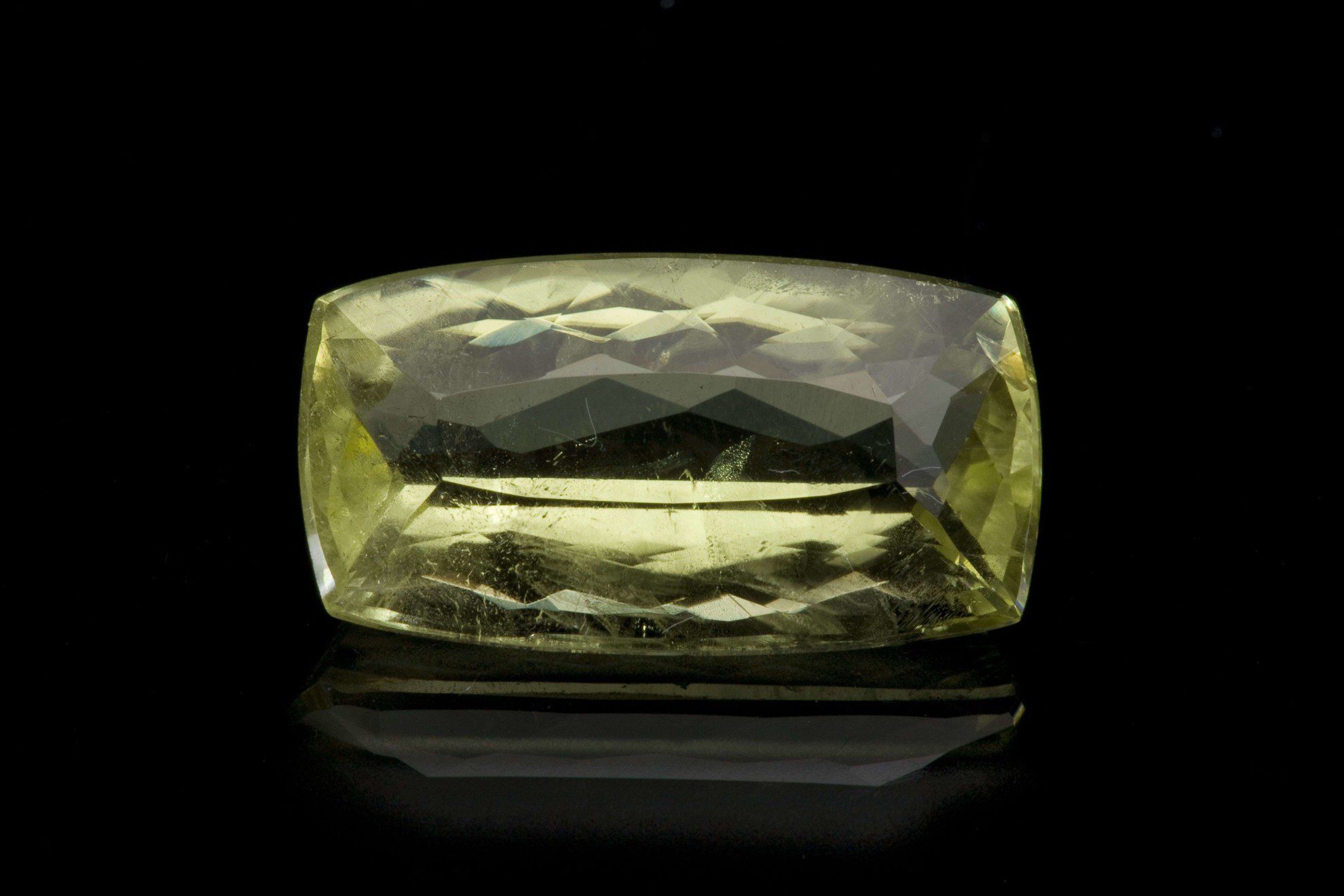
Brazilianite is primarily sought after for its aesthetic qualities and is highly valued as a gemstone. Its rarity, vibrant color, and unique crystal structure make it a desirable addition to gem collections and jewelry. Brazilianite gemstones are typically faceted to enhance their brilliance and showcase their attractive green to yellowish-green color.
While Brazilianite is primarily used in the creation of jewelry, it is important to note that due to its moderate hardness and perfect cleavage, it requires careful handling to prevent damage or fractures. It is best suited for jewelry pieces that are not subjected to excessive wear or potential impacts.
Beyond its ornamental use, Brazilianite does not have significant industrial applications. Its scarcity and relatively small crystal sizes limit its suitability for large-scale use in industrial processes. Brazilianite is predominantly valued for its beauty and rarity within the gem and mineral collecting community.
In addition to its aesthetic appeal, some individuals ascribe metaphysical properties to Brazilianite. It is believed to enhance personal power, creativity, and self-expression. Brazilianite is often associated with the solar plexus chakra, which is associated with confidence, willpower, and manifestation. However, it is important to note that these beliefs are subjective and not supported by scientific evidence.
Overall, the primary use of Brazilianite lies in the realm of gem and mineral collecting, where it is highly prized for its exceptional color and rarity. Its stunning appearance and limited availability make it a treasured gemstone among collectors and individuals seeking unique and beautiful jewelry pieces.
Rarity, Value, and Market
Brazilianite is considered a relatively rare gemstone, and its value in the market is influenced by factors such as its color, clarity, size, and overall quality. Here are some key points regarding the rarity, value, and market of Brazilianite:
- Rarity: Brazilianite is considered rare, particularly high-quality specimens with intense and vibrant green color. Its limited occurrence in specific pegmatite deposits, primarily in Brazil, contributes to its rarity in the market.
- Color and Clarity: The most desirable Brazilianite gemstones exhibit a rich, saturated green to yellowish-green color. Gems with excellent transparency and minimal inclusions are highly valued. Intense green specimens are generally more sought after than lighter or yellowish varieties.
- Size: Brazilianite crystals are typically small, and larger gem-quality specimens are relatively uncommon. Larger, well-cut Brazilianite gemstones command higher prices due to their scarcity.
- Cut and Shape: Brazilianite gemstones are often faceted into traditional gemstone cuts, such as ovals, rounds, or emerald cuts, to enhance their beauty and brilliance. Well-cut and symmetrical gemstones with good proportions tend to have higher value.
- Market Demand: Brazilianite has gained popularity among gemstone collectors and enthusiasts who appreciate its unique color, rarity, and association with Brazil. The market demand for Brazilianite gemstones is relatively niche compared to more well-known gemstones, which can affect its availability and pricing.
- Pricing: The price of Brazilianite can vary widely depending on factors such as size, color, clarity, and overall quality. In general, high-quality Brazilianite gemstones can range from a few hundred to several thousand dollars per carat, with larger and finer specimens commanding higher prices.
- Gemstone Certification: When purchasing Brazilianite or any gemstone, it is advisable to seek a reputable gemstone dealer or jeweler who can provide proper gemstone certification, which ensures the authenticity and quality of the gem.
It is worth noting that market trends and prices can fluctuate over time due to factors such as supply and demand, changes in fashion trends, and the availability of new gemstone discoveries. It is always recommended to do thorough research and consult with experts when buying or valuing Brazilianite gemstones.
FAQ
Is Brazilianite a common gemstone?
No, Brazilianite is considered a relatively rare gemstone due to its limited occurrence and specific geological conditions required for its formation.
What is the typical color of Brazilianite?
Brazilianite is known for its vibrant green to yellowish-green color. The intensity and shade of green can vary, ranging from pale to deep and intense hues.
Can Brazilianite be used in jewelry?
Yes, Brazilianite can be used in jewelry. It is primarily faceted into gemstones and set in various jewelry pieces such as rings, earrings, and pendants. However, due to its moderate hardness and perfect cleavage, it requires careful handling and is best suited for jewelry items that are not subjected to excessive wear or potential impacts.
Where is Brazilianite found?
The primary source of Brazilianite is Brazil, particularly in the Conselheiro Pena and Linópolis regions of the state of Minas Gerais. It is also found in smaller quantities in other countries such as the United States, Russia, Namibia, Afghanistan, and Portugal.
What is the hardness of Brazilianite?
On the Mohs scale of mineral hardness, Brazilianite has a hardness rating of 5.5 to 6. This places it in the range of moderately hard minerals.
Can Brazilianite be treated or enhanced?
No, Brazilianite is typically not treated or enhanced. It is valued for its natural color and properties.
Does Brazilianite have any special metaphysical properties?
Some individuals believe that Brazilianite enhances personal power, creativity, and self-expression. It is often associated with the solar plexus chakra and is believed to support confidence and willpower. However, these beliefs are subjective and not scientifically proven.
How rare are large Brazilianite gemstones?
Large Brazilianite gemstones are relatively rare due to the small size of the crystals typically found. Larger, high-quality specimens are highly sought after and command higher prices in the market.
Are there any synthetic or lab-grown Brazilianite gemstones?
As of my knowledge cutoff in September 2021, synthetic or lab-grown Brazilianite gemstones were not commercially available. Brazilianite is primarily sourced from natural deposits.
What should I consider when buying Brazilianite gemstones? When buying Brazilianite gemstones, it is important to consider factors such as color, clarity, size, cut, and overall quality. Seek a reputable gemstone dealer or jeweler who can provide proper gemstone certification to ensure the authenticity and quality of the gem.




































